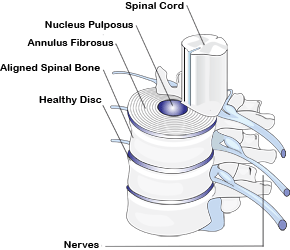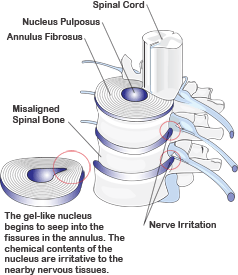Subluxation and the Disc
 |
 |
A subluxation is a spinal misalignment which causes nerve irritation or interference. Trauma to the spine, either from the accumulative effects of repeated minor episodes or from a single incident, begins a sequence of events which lead to subluxation and disc damage. Trauma misaligns a spinal vertebra. The shifted vertebra compresses the nucleus (center) of the disc forcing it against the annulus (outer rings). The fibers of the annulus become stretched and damaged causing an inflammatory reaction. The inflamed and swollen disc can potentially irritate the nearby spinal cord or nerve roots. To protect the area, surrounding muscles go into spasm to prevent excessive movement and damage. The lack of motion in the sublubluxated segment inhibits the disc’s normal pumping action causing the disc to dehydrate. The lack of water in the disc causes the annulus fibrosus to crack and fissure. This causes pain because the fibers of the annulus are richly supplied with pain- sensing nerves. The gel-like nucleus begins to seep into the fissures in the annulus. The chemical contents of the nucleus are irritative to the nearby nervous tissues. As more of the nucleus creeps into the annuar fissures, the disc bulges, herniates, or even possibly ruptures. This causes direct pressure on the spinal cord or nerve roots. Over time, degeneration occurs in the spinal joint, the irritated nerves and those systems which they supply.
